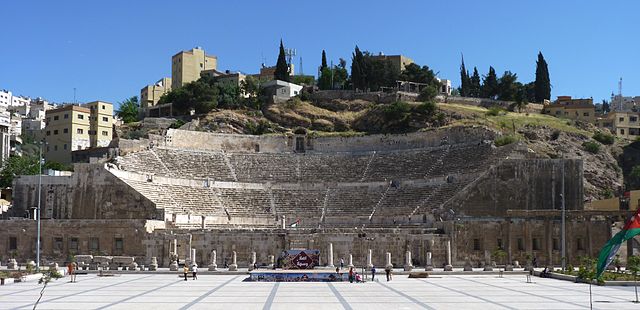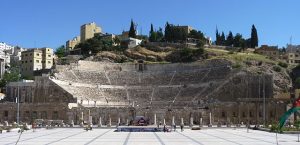Amman, One of the Finest Roman Theatres in the World
– Michael Nazzal of facebook page
the Kingdom of Jordan has many historical sites. Many different
civilizations have flourished in the area since ancient times. One of the most important and largest heritage sites is the Roman Theatre, Amman, which is one of the best examples of such a structure anywhere in the Middle East. Additionally, the theatre is one of the most complete structures of its type anywhere in the Levant, and it continues to play an important role in the cultural life of the area.
Ancient Rome to the modern day
The theatre was built by the Romans in what was then the Greek-city of Philadelphia and which is today known as Amman. Philadelphia was founded by the Macedonians after the conquest of the Persian Empire by Alexander the Great . It was one of the most important cities in the region and a hub for trade and commerce during the Seleucid Empire .
In 65 BC, Pompey the Great, conquered the area and incorporated it into the Roman Empire. The theatre was constructed during the reign of the Emperor Antonius Pius between 138 and 161 AD. It was possibly built by rich locals, in order to gain popularity and prestige in Philadelphia. This theatre would have staged mimes, recitals and tragedies and would have been very popular with the local citizenry. The city flourished for almost 400 years and eventually became part of the Eastern Roman Empire. It is probably then that the theatre ceased to stage theatrical productions as the area was Christianized. Many Christiansregarded all forms of theatre as sinful.
The city was conquered by the Muslims in the 630s, and the theatre may have been repurposed. Later earthquakes badly damaged the city and it was all but abandoned. The theatre too was badly damaged, and it was restored during the 20 th century. The new Jordanian government began to rebuild the structure in 1957, in order to boost tourism. The theatre is now a popular host for cultural activities including the Amman International Book Fair and musical concerts.
What’s there to see at the Roman Theatre, Amman?
The Roman Theatre Amman is cut into a hill, which is typical of any Roman theatre and it is northward facing so that the spectators would be shaded from the sun during performances. A colonnade can be seen before the theatre and some of the original columns can still be seen.There are a number of the original entrances still in use at the site, known as theparado.
Most of the theatre consists of steeped or tiered seating and they are divided into three horizontal sections. The seating area is known as the cavea, and the entire area offers a great view of the stage. At one time could accommodate 5-6000. In the Roman period, the seats would have been allocated based on wealth and social standing, with the best seats reserved for the rich. The seats closest to the stage were reserved for the military and the local elite. Once there was a shrine to the goddess Athena at the top tier of the cavea, and a sculpture from this can now be seen in the Jordan Museum.
The seats surround a small circular area that is known as the orchestra and adjacent to this are the remains of a small theatre known as the Odeon. It is worth noting that the acoustics in the theatre are excellent. The stage is very well preserved, and it includes scaenae frons , or the back wall of the stage. There is also a proscaenium, a low wall before the stage , and this was once decorated with statues. Near the entrances are two museums, one dedicated to Jordanian Popular Tradition and the other to the Folklore Museum. The theatre restoration remains controversial, and there are those who believe that the structure is not authentic, as it did not use original materials.
- Unexpected Statues of Mythological Goddess Unearthed in Jordan
- Bizarre Comical Frescoes Complete with Speech in a Lost Hybrid Language Found in Jordan Tomb
- Arles Amphitheatre – A Roman Treasure in the Soul of Provence
How to visit the Roman Theatre, Amman
The theatre is located in the center of Amman and is near the popular Hashemite Plaza. There is a small entrance fee required for admittance to the site and the museums. A visitor can freely explore the theatre when there are no performances being held. There are a number of tours that take in the theatre and other Roman sites. The historic structure is located near a 2nd century Roman fountain


